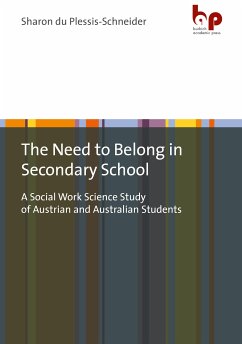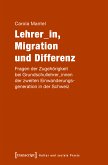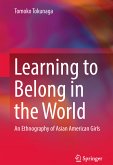The Need to Belong in Secondary School (eBook, PDF)
A Social Work Science Study of Austrian and Australian Students


Alle Infos zum eBook verschenken

The Need to Belong in Secondary School (eBook, PDF)
A Social Work Science Study of Austrian and Australian Students
- Format: PDF
- Merkliste
- Auf die Merkliste
- Bewerten Bewerten
- Teilen
- Produkt teilen
- Produkterinnerung
- Produkterinnerung

Hier können Sie sich einloggen

Bitte loggen Sie sich zunächst in Ihr Kundenkonto ein oder registrieren Sie sich bei bücher.de, um das eBook-Abo tolino select nutzen zu können.
Our social interactions are driven by complex biopsychic processes that are complicated by the fact that humans are individuals and at the same time members of one or more social systems, such as schools. This book contributes to explaining the social mechanisms influencing students' "need to belong" fulfilment at school. The theoretical framework is informed by human needs understood as cognitive mechanisms of neural processes that regulate human behaviour and bio-values. The fieldwork was conducted in two secondary schools in Austria and Australia. Based on the findings, the transformative…mehr
- Geräte: PC
- ohne Kopierschutz
- eBook Hilfe
- Größe: 2.6MB
- FamilySharing(5)
![Demokratiebildung in Verfahren der Qualitätsentwicklung in Kitas: Eine Dokumentenanalyse (eBook, PDF) Demokratiebildung in Verfahren der Qualitätsentwicklung in Kitas: Eine Dokumentenanalyse (eBook, PDF)]() Hoa Mai Tr¿nDemokratiebildung in Verfahren der Qualitätsentwicklung in Kitas: Eine Dokumentenanalyse (eBook, PDF)0,00 €
Hoa Mai Tr¿nDemokratiebildung in Verfahren der Qualitätsentwicklung in Kitas: Eine Dokumentenanalyse (eBook, PDF)0,00 €![Kinder als Akteure nachhaltiger Entwicklung (eBook, PDF) Kinder als Akteure nachhaltiger Entwicklung (eBook, PDF)]() Barbara BenoistKinder als Akteure nachhaltiger Entwicklung (eBook, PDF)33,99 €
Barbara BenoistKinder als Akteure nachhaltiger Entwicklung (eBook, PDF)33,99 €![Schulische Inklusion (eBook, PDF) Schulische Inklusion (eBook, PDF)]() Katharina ReschSchulische Inklusion (eBook, PDF)17,99 €
Katharina ReschSchulische Inklusion (eBook, PDF)17,99 €![Migrationspolitik auf der Flucht (eBook, PDF) Migrationspolitik auf der Flucht (eBook, PDF)]() Hans BloklandMigrationspolitik auf der Flucht (eBook, PDF)48,99 €
Hans BloklandMigrationspolitik auf der Flucht (eBook, PDF)48,99 €![Lehrer_in, Migration und Differenz (eBook, PDF) Lehrer_in, Migration und Differenz (eBook, PDF)]() Carola MantelLehrer_in, Migration und Differenz (eBook, PDF)0,00 €
Carola MantelLehrer_in, Migration und Differenz (eBook, PDF)0,00 €![Kritische Kinderrechtsforschung (eBook, PDF) Kritische Kinderrechtsforschung (eBook, PDF)]() Manfred LiebelKritische Kinderrechtsforschung (eBook, PDF)31,99 €
Manfred LiebelKritische Kinderrechtsforschung (eBook, PDF)31,99 €![Learning to Belong in the World (eBook, PDF) Learning to Belong in the World (eBook, PDF)]() Tomoko TokunagaLearning to Belong in the World (eBook, PDF)81,95 €
Tomoko TokunagaLearning to Belong in the World (eBook, PDF)81,95 €-
-
-
Dieser Download kann aus rechtlichen Gründen nur mit Rechnungsadresse in A, B, BG, CY, CZ, D, DK, EW, E, FIN, F, GR, H, IRL, I, LT, L, LR, M, NL, PL, P, R, S, SLO, SK ausgeliefert werden.
- Produktdetails
- Verlag: Budrich Academic Press
- Seitenzahl: 290
- Erscheinungstermin: 11. Juli 2022
- Englisch
- ISBN-13: 9783966659420
- Artikelnr.: 64288127
- Verlag: Budrich Academic Press
- Seitenzahl: 290
- Erscheinungstermin: 11. Juli 2022
- Englisch
- ISBN-13: 9783966659420
- Artikelnr.: 64288127
- Herstellerkennzeichnung Die Herstellerinformationen sind derzeit nicht verfügbar.
1 Introduction
1.1 Defining "belonging" and "need to belong"
1.2 Research problem
1.3 Aim and research questions
1.4 The conceptual framework
1.5 Summary and consequences for the research design
2 Needs, human rights, school social work
2.1 Austria: school social work
2.2 Australia: school social work
2.3 School social workers and human rights
2.4 Education, Bildung and didactics
2.5 Human rights framework for school Bildung and education
2.6 Austrian school education
2.7 Australian school education
2.8 Summary
3 Literature review on needs and student belonging
3.1 Children's needs, rights and wellbeing
3.2 Belonging as a psychological need
3.3 Interactions and social relationships
3.4 Membership as a determinant of belonging
3.5 Teachers fostering student belonging
3.6 Academic engagement
3.7 School environment
3.8 Heterogeneity and difference
3.9 Non-belonging and social exclusion
3.10 Summary
4 A conceptual framework based on theories of human need
4.1 Key concepts: theory, system and mechanism
4.2 Research on the historical perspectives of human need
4.3 Human needs and welfare science - Arlt, 1876 - 1960
4.4 Humanistic psychology and needs - Maslow, 1908-1970
4.5 Human needs in pedagogy - Mägdefrau, 1960
4.6 Biopsychic-social & cultural need theory - Obrecht, 1942
4.7 Synopses of human need across four need theories
4.8 Conceptualising the "need to belong"
4.9 Objections to human needs theories
4.10 Summary
PART II: Research design, data collection, analysis and findings
5 Research design
5.1 Ontology
5.2 Epistemology
5.3 Methodology
5.4 Case study
5.5 Observation
5.6 Focus groups
5.7 Ethical guidelines
5.8 Student voice
5.9 Characteristics of the research schools
5.10 Fieldwork at the school in Austria
5.11 Fieldwork at the school in Australia
5.12 Summary
6 The "need to belong" - the search for empirical evidence
6.1 Summarising the analyses as a methodological procedure
6.2 Individual student-based data analysis 6.3 Categories within four dimensions of belonging
6.4 Whole group analysis
6.5 Whole group analysis coding framework
6.6 Summary
7 Theoretical model and principles of general action
7.1 Theory model of the "need to belong"
7.2 Transdisciplinary knowledge in response to social problems
7.3 Principles of action: three-step transformative approach
7.4 Formulation of theoretical hypotheses
7.5 Formulation of action-theory working hypotheses
7.6 Formulation of general guidelines for action
7.7 Aligning the empirical findings with previous research
7.8 Summary
8 Findings and recommendations for the "need to belong"
8.1 Conceptual, theoretical, methodological contributions
8.2 Discussion of the individual student-based analysis
8.3 Discussion of the findings from the whole group analysis
8.4 Discussion of the transformative three-step approach
8.5 Reflections on the triple mandate of school social work
8.6 Heterogeneity facilitates student belonging
8.7 Suggestions for future research
1 Introduction
1.1 Defining "belonging" and "need to belong"
1.2 Research problem
1.3 Aim and research questions
1.4 The conceptual framework
1.5 Summary and consequences for the research design
2 Needs, human rights, school social work
2.1 Austria: school social work
2.2 Australia: school social work
2.3 School social workers and human rights
2.4 Education, Bildung and didactics
2.5 Human rights framework for school Bildung and education
2.6 Austrian school education
2.7 Australian school education
2.8 Summary
3 Literature review on needs and student belonging
3.1 Children's needs, rights and wellbeing
3.2 Belonging as a psychological need
3.3 Interactions and social relationships
3.4 Membership as a determinant of belonging
3.5 Teachers fostering student belonging
3.6 Academic engagement
3.7 School environment
3.8 Heterogeneity and difference
3.9 Non-belonging and social exclusion
3.10 Summary
4 A conceptual framework based on theories of human need
4.1 Key concepts: theory, system and mechanism
4.2 Research on the historical perspectives of human need
4.3 Human needs and welfare science - Arlt, 1876 - 1960
4.4 Humanistic psychology and needs - Maslow, 1908-1970
4.5 Human needs in pedagogy - Mägdefrau, 1960
4.6 Biopsychic-social & cultural need theory - Obrecht, 1942
4.7 Synopses of human need across four need theories
4.8 Conceptualising the "need to belong"
4.9 Objections to human needs theories
4.10 Summary
PART II: Research design, data collection, analysis and findings
5 Research design
5.1 Ontology
5.2 Epistemology
5.3 Methodology
5.4 Case study
5.5 Observation
5.6 Focus groups
5.7 Ethical guidelines
5.8 Student voice
5.9 Characteristics of the research schools
5.10 Fieldwork at the school in Austria
5.11 Fieldwork at the school in Australia
5.12 Summary
6 The "need to belong" - the search for empirical evidence
6.1 Summarising the analyses as a methodological procedure
6.2 Individual student-based data analysis 6.3 Categories within four dimensions of belonging
6.4 Whole group analysis
6.5 Whole group analysis coding framework
6.6 Summary
7 Theoretical model and principles of general action
7.1 Theory model of the "need to belong"
7.2 Transdisciplinary knowledge in response to social problems
7.3 Principles of action: three-step transformative approach
7.4 Formulation of theoretical hypotheses
7.5 Formulation of action-theory working hypotheses
7.6 Formulation of general guidelines for action
7.7 Aligning the empirical findings with previous research
7.8 Summary
8 Findings and recommendations for the "need to belong"
8.1 Conceptual, theoretical, methodological contributions
8.2 Discussion of the individual student-based analysis
8.3 Discussion of the findings from the whole group analysis
8.4 Discussion of the transformative three-step approach
8.5 Reflections on the triple mandate of school social work
8.6 Heterogeneity facilitates student belonging
8.7 Suggestions for future research







